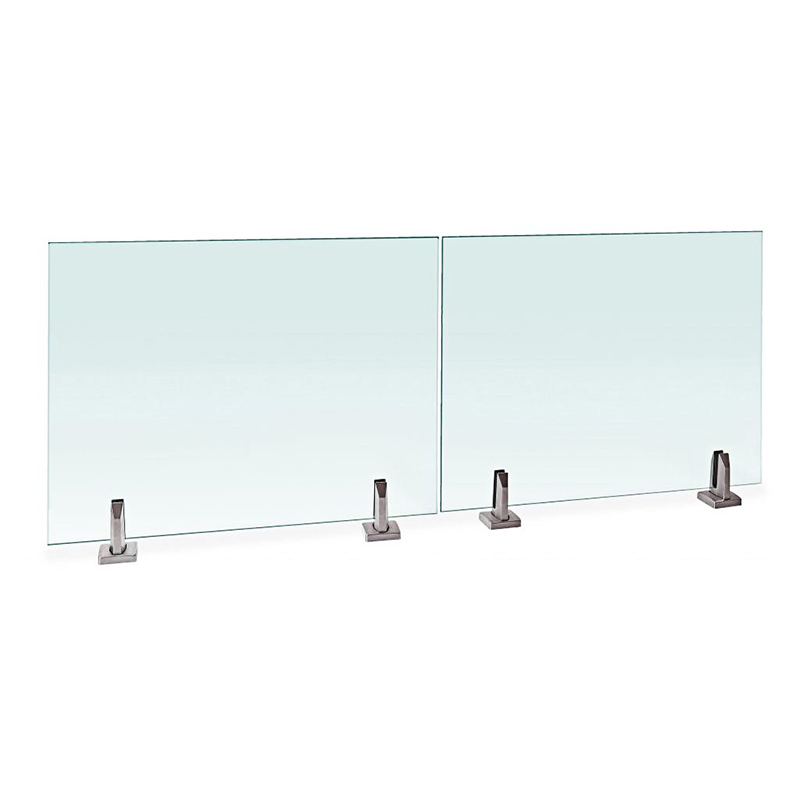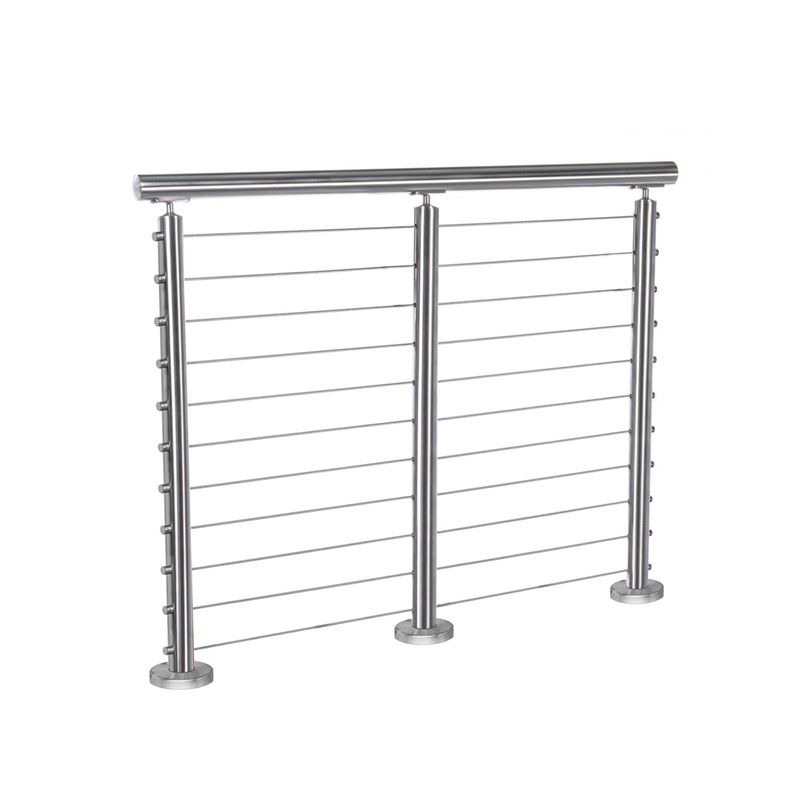Comprehensive Market Analysis: Top-Selling Railings for Sports Venues
Top-Selling Railing Systems for Sports Venues
The sports venue railing market is dominated by three primary railing systems that have proven most popular due to their superior combination of safety, durability, aesthetics, and compliance with industry standards.
Aluminum Railing Systems
Aluminum railings have emerged as the leading choice for sports venues, with powder-coated aluminum taking a particularly dominant position in the market.
Key Advantages:
- Lightweight yet strong construction
- Superior corrosion resistance in outdoor environments
- Low maintenance requirements
- Cost-effective for large installations
- Versatile design options with powder coating in team colors
Popular Applications: Aluminum railings are extensively used throughout sports venues, including staircases, upper decks, and general spectator areas where a balance of durability and aesthetics is required. The aluminum railing system by E-PAI, featuring metal infill panels, has become extremely popular in sports facilities of all types. These systems typically feature modular designs that simplify installation and reduce labor costs.
Glass Railing Systems
Frameless glass railing systems have gained significant popularity in premium seating areas and VIP sections of sports venues.
Key Advantages:
- Provides unobstructed views of the action
- Creates a modern, upscale aesthetic
- Highly customizable with options for team branding
- Available in tempered or laminated safety glass
- Can be integrated with LED lighting systems
Popular Applications: Glass railings are primarily used in club levels, luxury boxes, and premium seating areas where maintaining sightlines is critical while providing an upscale experience.
- Shoe/U-channel systems
- Standoff/spigot mounts
- Base shoe systems According to industry trends, frameless glass for unobstructed views ranks as the #1 railing system trend for 2025.
Stainless Steel Cable Railings
Cable railing systems have become increasingly popular in sports venues due to their modern aesthetic and minimal visual interference.
Key Advantages:
- High Safety
- Modern, clean appearance
- Exceptional durability in high-traffic areas
- Strong and safe while maintaining aesthetics
- Weather-resistant for outdoor applications
Popular Applications: Cable railings are widely used in areas where safety is important but full glass systems may be cost-prohibitive, such as general admission areas, outdoor stadiums, and walkways. "Cable railings offer the best of both worlds: they're built to last while also adding a contemporary touch to any space. Made from high-quality Type 316 stainless steel, these cables are tough enough to handle the wear and tear of high-traffic environments" .
Materials Analysis: Performance in Sports Venue Applications
The choice of materials significantly impacts railing performance in the demanding environment of sports venues. The following table compares the most widely used materials:
|
Material |
Durability Rating |
Maintenance Level |
Cost Range |
Visual Impact |
Key Benefits |
|
Aluminum |
★★★★☆ |
Low |
$19-$305/meter |
Moderate |
Lightweight, corrosion-resistant, low maintenance |
|
Stainless Steel |
★★★★★ |
Low-Medium |
$15-$300/meter |
High (premium) |
Maximum strength, weatherproof, premium appearance |
|
Tempered Glass |
★★★★☆ |
Medium |
$22-$140/m² |
Low (transparent) |
Unobstructed views, modern aesthetic |
|
Cable Systems |
★★★★☆ |
Low |
$30-$99/meter |
Low |
High safety, contemporary look |
|
Vertical Picket |
★★★★☆ |
Low |
$15-$50/meter |
Moderate |
Traditional appearance, robust construction |
|
Chain Link |
★★★☆☆ |
Low |
$15-$50/meter |
High (industrial) |
Most cost-effective, highly secure |
"Stainless steel, aluminum, wrought iron, and even glass can be excellent choices for high-traffic railing systems—provided they're fabricated to meet rigorous standards" Artec-Rail.
Safety Standards and Compliance Requirements
Safety is the primary consideration for sports venue railings, with several critical standards governing their design and installation:
Height Requirements
- Standard guardrail height: 42 inches (required by OSHA Standard 1910.29) Fallprotect
- Sightline-constrained areas: Minimum 31.5 inches (800 mm) Sportslitigationalert The reduced height allowance for sightline-constrained areas is controversial from a safety perspective, as many industry experts recommend maintaining the 42-inch standard throughout venues.
Load Resistance Standards
- Linear load requirement: 50 pounds per linear foot applied at the top rail
- Concentrated load: Must withstand a force of at least 200 pounds applied downward or outward within 2 inches of the top edge Lighthousesafety These load requirements are particularly critical in sports venues where excited fans may push against railings during key moments in events.
Material Safety Standards
- Glass railings must use safety glass (tempered or laminated)
- Materials must be non-combustible
- Spacing between balusters must prevent passage of a 4-inch sphere
- ADA compliance requires specific dimensions for graspability
Leading Manufacturers and Market Players
The sports venue railing market is dominated by several specialized manufacturers:
|
Manufacturer |
Specialty |
Notable Features |
Market Position |
|
E-Pai Commercial Solutions |
Aluminum, glass, custom railings |
Major stadium projects, comprehensive solutions |
Market leader for sports venues |
|
VIVA Railings |
Stainless steel, glass, modular systems |
Premium finishes, custom designs |
Premium commercial segment |
|
Hollaender |
Aluminum railing systems |
Interna-Rail® system, popular in sports facilities |
Strong presence in aluminum segment |
|
Tuttle Railings |
Non-ferrous welded and mechanical railings |
Large fabrication capacity |
Major U.S. fabricator |
|
Southern Bleacher |
Stadium fencing and railings |
Chain link, vertical picket, custom options |
Specialized in grandstand systems |
|
Superior Aluminum |
Commercial aluminum railings |
Sleek designs, durable construction |
Strong in aluminum segment |
E-Pai Commercial Solutions has emerged as a particularly prominent player, with their railing fabrications featured in numerous major stadiums across North America.
Current Trends and Innovations in Sports Venue Railings
The sports venue railing market continues to evolve with several key trends shaping current designs:
- Frameless Glass for Unobstructed Views - The top trend for 2025, providing maximum visibility while maintaining safety
- Powder-Coated Aluminum - Taking the lead due to its versatility, durability, and customization options
- Mixed Materials for Texture and Contrast - Combining aluminum, glass, and stainless steel for distinctive looks
- Smart Railings With Integrated Features - LED lighting integration, digital displays, and sensor technology
- Clean Lines and Open-Concept Designs - Minimalist approaches that maximize visibility while maintaining safety
Installation and Maintenance Considerations
Installation Requirements
- Anchoring systems appropriate for the substrate (concrete, steel, etc.)
- Modular systems that simplify installation and reduce labor costs
- Expansion/contraction allowances for outdoor applications
- Compliance with local building codes and ADA requirements
Maintenance Factors
- Aluminum and stainless steel systems require minimal maintenance
- Glass systems need regular cleaning to maintain visibility
- Powder-coated finishes should be selected to withstand aggressive cleaning methods
- Maintenance requirements include scratch removal, oxidation treatment, and periodic inspections
Customization Options and Special Features
Modern sports venue railings often incorporate specialized features:
- Team branding and color schemes through powder coating
- Integrated LED lighting systems
- Digital display integration
- Custom graphics and sponsor messaging opportunities
- Specialized crowd control features
Product Showcase
Pricing Considerations
The cost of sports venue railings varies widely based on materials, design complexity, and installation requirements:
|
Railing Type |
Price Range |
Value Proposition |
|
Aluminum Railings |
$19-$305/meter |
Best balance of cost, durability, and aesthetics |
|
Stainless Steel |
$15-$300/meter |
Premium appearance, maximum durability |
|
Glass Systems |
$22-$140/m² |
Optimal visibility, modern look |
|
Cable Railings |
$30-$99/meter |
Modern appearance with good visibility |
|
Vertical Picket/Chain Link |
$15-$50/meter |
Most economical option |
Premium venues typically invest in higher-end systems that offer better aesthetics and durability, while smaller venues may opt for more economical solutions.
Buyer's Guide: Key Considerations
When selecting railings for sports venues, buyers should prioritize:
- Safety Compliance - Ensure railings meet or exceed all relevant safety codes
- Durability in High-Traffic Environments - Select materials that can withstand continuous use
- Maintenance Requirements - Consider long-term maintenance costs and procedures
- Visibility and Sightlines - Balance safety with spectator experience
- Aesthetic Considerations - Align with venue design and branding
- Installation Complexity - Evaluate installation requirements and associated costs
- Customization Options - Consider opportunities for branding and sponsor integration
Conclusion
The top-selling railings for sports venues demonstrate a clear market preference for systems that balance safety, durability, aesthetics, and value. Aluminum, glass, and stainless steel systems dominate the market, with specific preferences depending on the application area within venues.
Leading manufacturers have developed specialized systems that cater to the unique requirements of sports venues, with emphasis on strength, durability, and visual appeal. The market continues to evolve with innovations in materials, integration of technology, and customization options.
When selecting railings for sports venues, decision-makers should prioritize safety standards compliance while balancing visual impact, long-term durability, and maintenance requirements. The variety of options available allows for tailored solutions that meet both functional requirements and aesthetic preferences for any sports venue.



